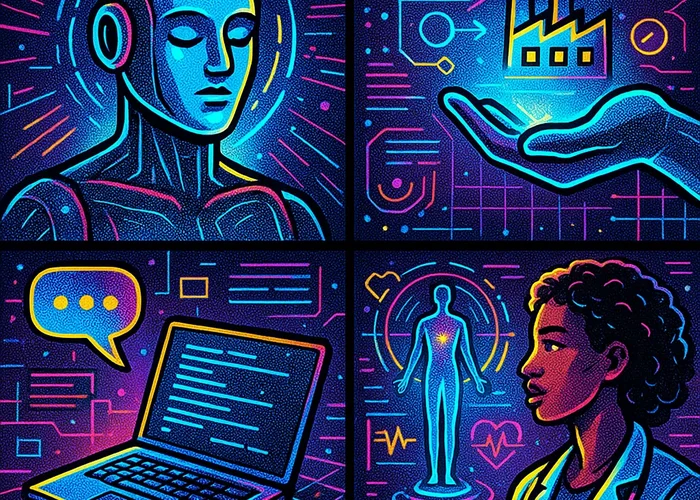Large Language Models (LLMs) Overview: Key Industry Applications & Insights
Explore the key applications of LLMs across healthcare, finance, and education. Learn how large language models are transforming industries today.

Large Language Models (LLMs) Overview: Key Industry Applications & Insights
At a Glance
- The global market for large language models (LLMs) is projected to reach over $82 billion by 2033, driven by rapid adoption across industries.
- LLMs are revolutionizing sectors such as healthcare, finance, and education by enabling more personalized, efficient, and data-driven services.
- Advanced models like GPT, BERT, and LLaMA differ in architecture and capabilities, influencing their suitability for specific applications.
- Ethical challenges, including bias and fairness, remain critical considerations as LLM deployment expands.
- Future trends point towards multi-modal models and increased focus on responsible AI development.
What Are Large Language Models?
Understanding LLMs and Their Capabilities
Large Language Models (LLMs) are a subset of artificial intelligence (AI) systems trained on massive datasets to understand, generate, and interpret human language. These models leverage deep learning NLP techniques, particularly transformer architectures, to produce coherent and contextually relevant text. Notable models include OpenAI's GPT series, Google’s BERT, Meta’s LLaMA, and Google DeepMind’s Gemini.
The evolution of LLMs has been characterized by increasing scale and sophistication, enabling applications that range from conversational agents to complex data analysis. Their ability to process vast amounts of information allows them to perform tasks such as summarization, translation, question answering, and content creation.
Natural Language Processing and AI Integration
LLMs have significantly advanced natural language processing by enabling AI systems to comprehend nuanced language patterns. This progress is rooted in deep learning NLP, where models are trained on billions of words, improving their contextual understanding. These large-scale AI models are now integral to many applications, supporting industries in automating and enhancing communication workflows.

For further insights into popular LLMs, explore KDnuggets’ overview of 7 popular LLMs explained in 7 minutes.
Key Applications of LLMs in Various Industries
LLMs in Healthcare: Transforming Patient Care and Research
In healthcare, LLMs are revolutionizing how medical data is analyzed and utilized. They assist clinicians by analyzing electronic health records, identifying disease patterns, and enabling personalized treatment plans. For example, LLMs can interpret unstructured clinical notes and medical literature, accelerating diagnosis and research.
Recent research indicates that LLMs support drug discovery, medical imaging analysis, and patient engagement through AI-powered chatbots. However, ethical considerations such as bias and data privacy remain at the forefront, emphasizing the need for responsible AI deployment.
LLMs in Finance: Enhancing Data Analysis and Decision-Making
The financial sector leverages LLMs for fraud detection, risk assessment, and automated customer service. These models excel at parsing complex financial documents, generating insights, and supporting decision-making processes. For instance, they enable real-time market analysis and personalized financial advice.
According to recent market data, the financial industry is a significant segment of the LLM market, which is expected to reach $82.1 billion by 2033. Innovations like few-shot learning and multilingual capabilities, exemplified by Google’s PaLM, are enhancing the effectiveness of AI language models in finance.
Educational Technologies Powered by LLMs
Educational technology benefits from LLMs through personalized learning experiences, automated grading, and intelligent tutoring systems. These models can adapt content based on individual learner needs, making education more accessible and engaging.
Emerging educational tools incorporate large-scale models to facilitate language learning, provide instant feedback, and generate tailored content. As LLMs evolve, their integration into educational platforms promises to reshape how knowledge is delivered and consumed.
Challenges and Future Trends of LLMs
Ethical Considerations and Limitations
Despite their transformative potential, LLMs face significant challenges. Bias and fairness are critical concerns, as models trained on biased datasets can perpetuate stereotypes and unfair practices in applications like hiring or law enforcement (IEEE Xplore, 2025). Ensuring transparency and developing fair AI systems are ongoing priorities.

Additionally, issues related to data privacy, model interpretability, and computational costs pose hurdles. The industry is actively researching ways to mitigate these concerns, including developing more efficient models like Mistral, a French startup optimizing inference and reasoning tasks with fewer parameters.
Emerging Trends and the Future of LLMs
The future of large language models points toward multi-modal AI systems that combine text, images, and code, as exemplified by Google DeepMind’s Gemini. These models aim to handle complex, multi-faceted tasks across industries more effectively.
Furthermore, responsible AI development involves addressing biases, improving model explainability, and ensuring ethical deployment. As technology advances, LLMs are expected to become more accessible, efficient, and aligned with human values.
Unlock More Industry Insights
Stay ahead in the AI industry by subscribing to our newsletter for the latest updates on LLM advancements, market trends, and ethical developments. For a deeper dive, download our comprehensive report on LLM applications across sectors or contact us for expert consulting services.


